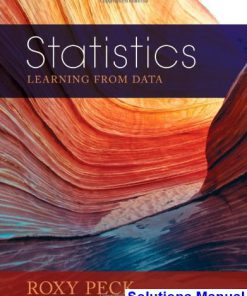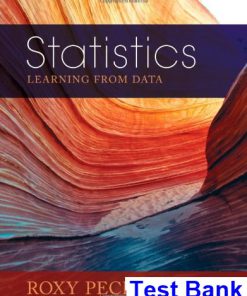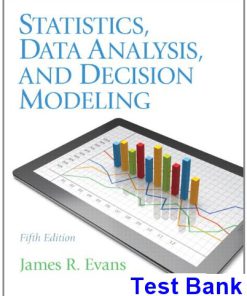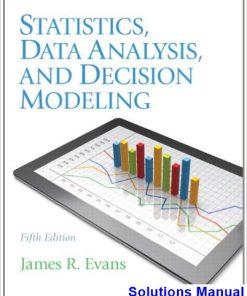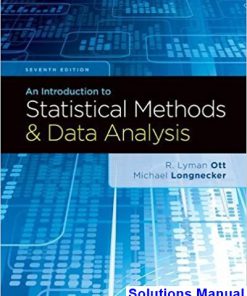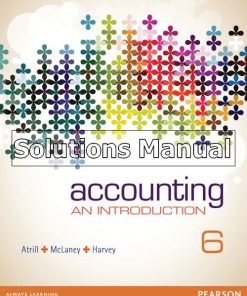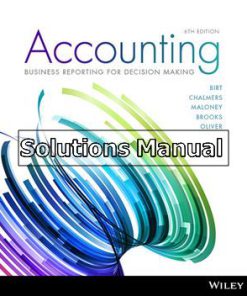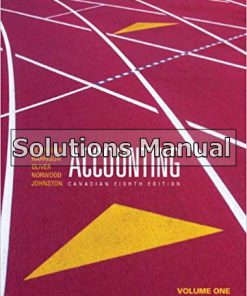Introduction to Statistics and Data Analysis 5th Edition Peck Solutions Manual
$26.50$50.00 (-47%)
Introduction to Statistics and Data Analysis 5th Edition Peck Solutions Manual.
You may also like
Instant download Introduction to Statistics and Data Analysis 5th Edition Peck Solutions Manual pdf docx epub after payment.

Product details:
- ISBN-10 : 1305115341
- ISBN-13 : 978-1305267244
- Author:
Introduction to Statistics and Data Analysis 5th Edition Peck Test Bank
Table of contents:
1. THE ROLE OF STATISTICS AND THE DATA ANALYSIS PROCESS: Why Study Statistics? The Nature and Role of Variability. Statistics and the Data Analysis Process. Types of Data and Some Simple Graphical Displays.
2. COLLECTING DATA SENSIBLY: Statistical Studies: Observation and Experimentation. Sampling. Simple Comparative Experiments. More on Experimental Design. Interpreting and Communicating the Results of Statistical Analyses. More on Observational Studies: Designing Surveys (online).
3. GRAPHICAL METHODS FOR DESCRIBING DATA: Displaying Categorical Data: Comparative Bar Charts and Pie Charts. Displaying Numerical Data: Stem-and-Leaf Displays. Displaying Numerical Data: Frequency Distributions and Histograms. Displaying Bivariate Numerical Data. Interpreting and Communicating the Results of Statistical Analyses.
4. NUMERICAL METHODS FOR DESCRIBING DATA: Describing the Center of a Data Set. Describing Variability in a Data Set. Summarizing a Data Set: Boxplots. Interpreting Center and Variability: Chebyshev’s Rule, the Empirical Rule, and z Scores. Interpreting and Communicating the Results of Statistical Analyses.
5. SUMMARIZING BIVARIATE DATA: Correlation. Linear Regression: Fitting a Line to Bivariate Data. Assessing the Fit of a Line. Nonlinear Relationships and Transformations. Interpreting and Communicating the Results of Statistical Analyses. Logistic Regression (online).
6. PROBABILITY: Chance Experiments and Events. Definition of Probability. Basic Properties of Probability. Conditional Probability. Independence. Some General Probability Rules. Estimating Probabilities Empirically Using Simulation.
7. RANDOM VARIABLES AND PROBABILITY DISTRIBUTIONS: Random Variables. Probability Distributions for Discrete Random Variables. Probability Distributions for Continuous Random Variables. Mean and Standard Deviation of a Random Variable. Binomial and Geometric Distributions. Normal Distributions. Checking for Normality and Normalizing Transformations. Using the Normal Distribution to Approximate a Discrete Distribution.
8. SAMPLING VARIABILITY AND SAMPLING DISTRIBUTIONS: Statistics and Sampling Variability. The Sampling Distribution of a Sample Mean. The Sampling Distribution of a Sample Proportion.
9. Estimation Using a Single Sample: Point Estimation. Large-Sample Confidence Interval for a Population Proportion. Confidence Interval for a Population Mean. Interpreting and Communicating the Results of Statistical Analyses.
10. HYPOTHESIS TESTING USING A SINGLE SAMPLE: Hypotheses and Test Procedures. Errors in Hypothesis Testing. Large-Sample Hypothesis Tests for a Population Proportion. Hypothesis Tests for a Population Mean. Power and Probability of Type II Error. Interpreting and Communicating the Results of Statistical Analyses.
11. COMPARING TWO POPULATIONS OR TREATMENTS: Inferences Concerning the Difference Between Two Population or Treatment Means Using Independent Samples. Inferences Concerning the Difference Between Two Population or Treatment Means Using Paired Samples. Large-Sample Inferences Concerning the Difference Between Two Population or Treatment Proportions. Interpreting and Communicating the Results of Statistical Analyses.
12. THE ANALYSIS OF CATEGORICAL DATA AND GOODNESS-OF-FIT TESTS: Chi-Square Tests for Univariate Data. Tests for Homogeneity and Independence in a Two-way Table. Interpreting and Communicating the Results of Statistical Analyses.
13. SIMPLE LINEAR REGRESSION AND CORRELATION: INFERENTIAL METHODS: Simple Linear Regression Model. Inferences about the Slope of the Population Regression Line. Checking Model Adequacy. Inferences Based on the Estimated Regression Line (online). Inferences About the Population Correlation Coefficient (online). Interpreting and Communicating the Results of Statistical Analyses (online).
14. MULTIPLE REGRESSION ANALYSIS: Multiple Regression Models. Fitting a Model and Assessing Its Utility. Inferences Based on an Estimated Model (online). Other Issues in Multiple Regression (online). Interpreting and Communicating the Results of Statistical Analyses (online).
15. ANALYSIS OF VARIANCE: Single-Factor ANOVA and the F Test. Multiple Comparisons. The F Test for a Randomized Block Experiment (online). Two-Factor ANOVA (online). Interpreting and Communicating the Results of Statistical Analyses (online).
16. NONPARAMETRIC (DISTRIBUTION-FREE) STATISTICAL METHODS (ONLINE): Distribution-Free Procedures for Inferences About a Difference Between Two Population or Treatment Means Using Independent Samples (Optional). Distribution Free Procedures for Inferences About a Difference Between Two Population or Treatment Means Using Paired Samples. Distribution-Free ANOVA.
People also search:
introduction of data analysis
basic statistics for data analysis
beginning statistics with data analysis
what is introduction to statistics
statistics for data analysis
what is data analysis and statistics
statistical concepts for data analysis

